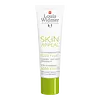What's inside
What's inside
 Key Ingredients
Key Ingredients

 Benefits
Benefits

 Concerns
Concerns

 Ingredients Side-by-side
Ingredients Side-by-side

Water
Skin ConditioningGlycerin
HumectantDibutyl Adipate
EmollientDistarch Phosphate
AbsorbentButyl Methoxydibenzoylmethane
UV AbsorberArginine
MaskingOctocrylene
UV AbsorberPanthenol
Skin ConditioningCetearyl Isononanoate
EmollientPhenylbenzimidazole Sulfonic Acid
UV AbsorberTocopheryl Acetate
AntioxidantPhenoxyethanol
PreservativePolysilicone-15
UV FilterCetearyl Olivate
Potassium Cetyl Phosphate
EmulsifyingParfum
MaskingRosa Centifolia Flower Extract
AstringentSorbitan Olivate
EmulsifyingCarbomer
Emulsion StabilisingCetyl Alcohol
EmollientPropylene Glycol
HumectantSorbitol
HumectantEthylhexylglycerin
Skin ConditioningXanthan Gum
EmulsifyingDisodium EDTA
Sodium Lactate
BufferingSodium Hyaluronate
HumectantCollagen Amino Acids
MoisturisingLactic Acid
BufferingPantolactone
HumectantSerine
MaskingUrea
BufferingGlycine
BufferingGlucose
HumectantAllantoin
Skin ConditioningWater, Glycerin, Dibutyl Adipate, Distarch Phosphate, Butyl Methoxydibenzoylmethane, Arginine, Octocrylene, Panthenol, Cetearyl Isononanoate, Phenylbenzimidazole Sulfonic Acid, Tocopheryl Acetate, Phenoxyethanol, Polysilicone-15, Cetearyl Olivate, Potassium Cetyl Phosphate, Parfum, Rosa Centifolia Flower Extract, Sorbitan Olivate, Carbomer, Cetyl Alcohol, Propylene Glycol, Sorbitol, Ethylhexylglycerin, Xanthan Gum, Disodium EDTA, Sodium Lactate, Sodium Hyaluronate, Collagen Amino Acids, Lactic Acid, Pantolactone, Serine, Urea, Glycine, Glucose, Allantoin
Water
Skin ConditioningAlcohol Denat.
AntimicrobialDistarch Phosphate
AbsorbentCarthamus Tinctorius Seed Oil
MaskingDi-C12-13 Alkyl Malate
EmollientGlycerin
HumectantPropanediol
SolventIsoamyl Laurate
EmollientButyl Avocadate
Skin ConditioningPanthenol
Skin ConditioningEthylhexylglycerin
Skin ConditioningTocopheryl Acetate
AntioxidantAmmonium Acryloyldimethyltaurate/Vp Copolymer
Isoamyl Cocoate
Allantoin
Skin ConditioningHydrolyzed Jojoba Esters
Skin ConditioningAcrylates/C10-30 Alkyl Acrylate Crosspolymer
Emulsion StabilisingDisodium EDTA
Tocopherol
AntioxidantArginine
MaskingPantolactone
HumectantWater, Alcohol Denat., Distarch Phosphate, Carthamus Tinctorius Seed Oil, Di-C12-13 Alkyl Malate, Glycerin, Propanediol, Isoamyl Laurate, Butyl Avocadate, Panthenol, Ethylhexylglycerin, Tocopheryl Acetate, Ammonium Acryloyldimethyltaurate/Vp Copolymer, Isoamyl Cocoate, Allantoin, Hydrolyzed Jojoba Esters, Acrylates/C10-30 Alkyl Acrylate Crosspolymer, Disodium EDTA, Tocopherol, Arginine, Pantolactone
Ingredients Explained
These ingredients are found in both products.
Ingredients higher up in an ingredient list are typically present in a larger amount.
Allantoin is a soothing ingredient known for its protective and moisturizingg properties. Because of this, it is often added to products with strong active ingredients.
Studies show higher concentrations of this ingredient can promote wound healing.
Though it can be derived from the comfrey plant, allantoin is produced synthetically for cosmetic products to ensure purity.
Learn more about AllantoinArginine is an amino acid that is important for human development. Your body uses is it to produce hair keratin and skin collagen.
As a cosmetic ingredient, Arginine has antioxidant properties and can also help repair damaged skin. This ingredient is derived either synthetically or from animals.
Arginine isn't fungal acne safe when used in the presence of other lipids (fats, fatty acids, oils, esters, etc). Oils and fats occur naturally within the skin, so take caution when using Arginine if you're prone to fungal acne.
Learn more about ArginineDisodium EDTA plays a role in making products more stable by aiding other preservatives.
It is a chelating agent, meaning it neutralizes metal ions that may be found in a product.
Disodium EDTA is a salt of edetic acid and is found to be safe in cosmetic ingredients.
Learn more about Disodium EDTAWe don't have a description for Distarch Phosphate yet.
Ethylhexylglycerin (we can't pronounce this either) is commonly used as a preservative and skin softener. It is derived from glyceryl.
You might see Ethylhexylglycerin often paired with other preservatives such as phenoxyethanol. Ethylhexylglycerin has been found to increase the effectiveness of these other preservatives.
Glycerin is already naturally found in your skin. It helps moisturize and protect your skin.
A study from 2016 found glycerin to be more effective as a humectant than AHAs and hyaluronic acid.
As a humectant, it helps the skin stay hydrated by pulling moisture to your skin. The low molecular weight of glycerin allows it to pull moisture into the deeper layers of your skin.
Hydrated skin improves your skin barrier; Your skin barrier helps protect against irritants and bacteria.
Glycerin has also been found to have antimicrobial and antiviral properties. Due to these properties, glycerin is often used in wound and burn treatments.
In cosmetics, glycerin is usually derived from plants such as soybean or palm. However, it can also be sourced from animals, such as tallow or animal fat.
This ingredient is organic, colorless, odorless, and non-toxic.
Glycerin is the name for this ingredient in American English. British English uses Glycerol/Glycerine.
Learn more about GlycerinPanthenol is a common ingredient that helps hydrate and soothe the skin. It is found naturally in our skin and hair.
There are two forms of panthenol: D and L.
D-panthenol is also known as dexpanthenol. Most cosmetics use dexpanthenol or a mixture of D and L-panthenol.
Panthenol is famous due to its ability to go deeper into the skin's layers. Using this ingredient has numerous pros (and no cons):
Like hyaluronic acid, panthenol is a humectant. Humectants are able to bind and hold large amounts of water to keep skin hydrated.
This ingredient works well for wound healing. It works by increasing tissue in the wound and helps close open wounds.
Once oxidized, panthenol converts to pantothenic acid. Panthothenic acid is found in all living cells.
This ingredient is also referred to as pro-vitamin B5.
Learn more about PanthenolPantolactone is a synthetically created humectant.
As a humectant, Pantolactone helps draw moisture to the skin. It can help add hydration to your skin.
Tocopheryl Acetate is AKA Vitamin E. It is an antioxidant and protects your skin from free radicals. Free radicals damage the skin by breaking down collagen.
One study found using Tocopheryl Acetate with Vitamin C decreased the number of sunburned cells.
Tocopheryl Acetate is commonly found in both skincare and dietary supplements.
Learn more about Tocopheryl AcetateWater. It's the most common cosmetic ingredient of all. You'll usually see it at the top of ingredient lists, meaning that it makes up the largest part of the product.
So why is it so popular? Water most often acts as a solvent - this means that it helps dissolve other ingredients into the formulation.
You'll also recognize water as that liquid we all need to stay alive. If you see this, drink a glass of water. Stay hydrated!
Learn more about Water